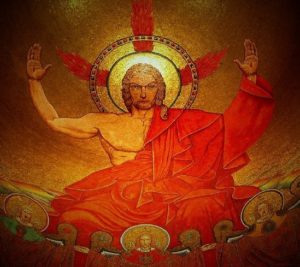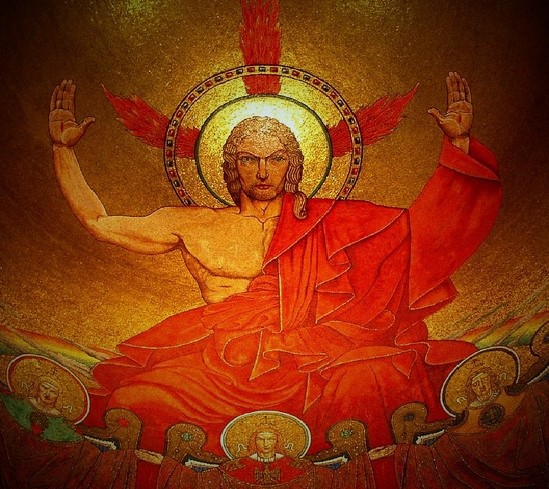 The first reading from Tuesday of the 34th week of the year seems, to modern readers, to be a complex tapestry of visions. I could see a bit of bewilderment on the faces of those listening at the early Mass. Ultimately, though, the message is simple and clear: nations and empires come and go, but the Lord and His Kingdom shall never pass away.
The first reading from Tuesday of the 34th week of the year seems, to modern readers, to be a complex tapestry of visions. I could see a bit of bewilderment on the faces of those listening at the early Mass. Ultimately, though, the message is simple and clear: nations and empires come and go, but the Lord and His Kingdom shall never pass away.
I propose here not an academic treatment of the passage (Daniel 2:31-45) but more a brief admonition. In the reading, Daniel interprets a dream of the Babylonian King Nebuchadnezzar in which he saw a fearsome statue composed of four different materials; the statue is ultimately destroyed by a large rock. Daniel interprets the four materials as four kingdoms that rise and fall. The rock is a king (Jesus) with an eternal kingdom that overcomes all. Modern scholars generally interpret the four kingdoms as Babylon, Persia, Greece, and Rome. These kingdoms interacted with and oppressed the Jewish people prior to the coming of Christ:
Babylon:
You, O king, are the king of kings;
to you the God of heaven
has given dominion and strength, power and glory;
men, wild beasts, and birds of the air, wherever they may dwell,
he has handed over to you, making you ruler over them all;
you are the head of gold.
Persia:
Another kingdom (of silver) shall take your place, inferior to yours,
Greece:
then a third kingdom, of bronze,
which shall rule over the whole earth.
Rome:
There shall be a fourth kingdom, strong as iron;
it shall break in pieces and subdue all these others,
just as iron breaks in pieces and crushes everything else.
The feet and toes you saw, partly of potter’s tile and partly of iron,
mean that it shall be a divided kingdom,
but yet have some of the hardness of iron.
Indeed, the vision comports well with how history unfolded in that period. The Persians did defeat the Babylonians. Greece, under Alexander the Great, did conquer much of the known world, from Greece to as far east as India—and in just ten years! Then came the Romans, who added the Mediterranean world to their immense empire. Later that empire divided, as Daniel said: the Western Empire in Europe and the Eastern Empire in Constantinople and Byzantium.
Yet, out of this cauldron of war and conquest emerged the true King of Kings. He was born in the small backwater town of Bethlehem. He did not command armies or men with swords and shields; He probably never journeyed more than 100 miles from the place of His birth. After a mere three years of teaching in the rural districts of the oppressed nation of Israel, He was killed by the Romans and His own people. Pilate mockingly announced, “Behold your King!” and then ordered Him crucified.
To our proud world, that is the end of the story, but the Lord conquered pride by His humility and rose from the dead. Daniel prophesied of this King and His Kingdom:
In the lifetime of those kings
the God of heaven will set up a kingdom
that shall never be destroyed or delivered up to another people;
rather, it shall break in pieces all these kingdoms
and put an end to them, and it shall stand forever.
That is the meaning of the stone you saw hewn from the mountain
without a hand being put to it,
which broke in pieces the tile, iron, bronze, silver, and gold.
The great God has revealed to the king what shall be in the future;
this is exactly what you dreamed, and its meaning is sure.
Yes, Christ reigns and rules. He is the Lord of history. We read further of this King and Messiah later in the Book of Daniel:
And I saw One like a Son of Man coming with the clouds of heaven. He approached the Ancient of Days and was led into His presence. And He was given dominion, glory, and kingship, that the people of every nation and language should serve Him. His dominion is an everlasting dominion that will not pass away, and His kingdom is one that will never be destroyed (Dan 7:13-14).
This passage from Daniel 7 surrounds the great Pantocrator image of Christ in the Basilica of the National Shrine of the Immaculate Conception (see picture above). When I am processing into the Basilica I am always moved as I ponder the image and the text, for indeed the vision is true. Empires have risen and fallen, nations have come and gone, every sort of foolishness and heresy has had its day; yet here we are, two thousand years later, still preaching the same gospel, given to us by our Head and Founder, Jesus Christ, the eternal King.
Do not be mesmerized by or too fearful of the kings and kingdoms of this world. I have walked in the ruins of many once-great cities and kingdoms. We have here on earth no lasting city, and so we look to that unconquerable, eternal city and Kingdom. Only what you do for Christ will last. He is the Rock. Christ is the King. He is Lord and Savior of the all the nations. He alone is my rock, my fortress, and my deliverer. His dominion is everlasting. His Kingdom alone shall never be destroyed.


Msgr. when I think of Daniel, I think of the priest God used to bring me to the faith…so many little signs in life. ( I’m thankful you haven’t posted anything personal about me, maybe you just want to share my posts but I just prefer like it was before, amen.)
I think He was born in the backwater town of Bethlehem
Christ Almighty is King of the Universe. Amen. While still in the ordinary time, please, allow me some considerations on the calendar. First, the Jewish calendar is a lunar calendar, with 12 lunar months in one year, from autumn equinox to autumn equinox, and 7 leap months in 19 years. The calendar month is from new moon to new moon, not from astronomical new moon, but from first visible crescent. According to the New Jerusalem Bible: Timetable, the date of the birth of our Lord was probably B.C. 5, and the date of his death was probably 7th April A.D. 30. This fits with Jesus beginning his public ministry at age 30 years, in springtime A.D. 27 (remember, there is no year 0). This was the fifteenth year of the emperor Tiberius (if his three years coregency is included), and the temple had been built upon for 46 years. There was a comet spotted in springtime B.C. 5, but if the nativity star indeed stood still over Bethlehem, the comet only led the three wise men to decide on their journey, but the nativity star showed itself to them to lead them to the exact place, as a kind of reward for faith. So the date of birth can be 25th December. As regards our Lady the Holy Virgin Mary, one can speculate that she lived simultaneously with the temple, in which case she was born in B.C. 20 and slept into heaven in A.D. 70. According to tradition, she grew up in the temple. Joseph was probably a young man, when they married, and the socalled brethren of Jesus (of whom Jacob, Simon, and Judas were apostles) are believed to be sons of Joseph’s relative, Halphaeus or Clophas. As regards the calendar, our modern calendar is off with three years. Our definition of the vernal equinox (and the winter solstice) is also off with two or three days, which was the error accumulated error in the Julian calendar between Christ’s birth and the Niceane council. If one wishes to harmonize the calendar with Christ’s birth rather than with the golden age of the Church, one can reform the calendar by leaping directly from 31st December 2096 to 1st January 2100, for the three years, and by letting the years, 2088, 2092, and 2096 not be leap years, for the two or three days (anyway, 2100 is not a leap year). On the other hand, if the Second Vatican Council proposed the possibility of fixing the date of Easter in the civic calendar, by harmonizing the solar year, the lunar month, and the seventh days week, this is not possible. But that was only in an appendix.
Indeed, All the world’s kings and kingdoms shall pass away.
All of the dead shall be raised back to life.
The books shall be opened. Our fufillment of the commands to love God and neighbor will be examined. Today’s free gospel offer of God’s love and mercy will have come to an end. Judgment will arrive.
Indeed, Worthy is the Lamb (the LORD Jesus Christ) that was slain. He was sinless and the first to rise from the dead never to die again.